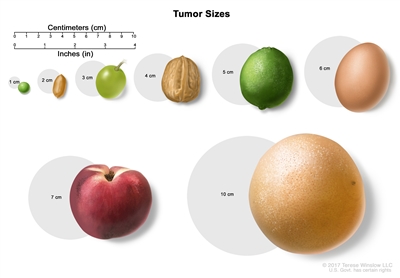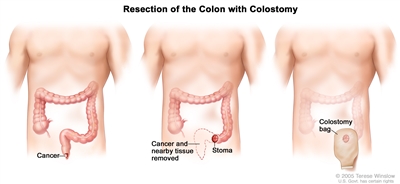General Information About Anal Cancer
Anal cancer is a type of cancer that forms in the tissues of the anus.
The anus is the end of the large intestine. It is where stool (solid waste) leaves the body. The anus is formed partly from the outer skin layers of the body and partly from the intestine. The anus is connected to the rectum by the anal canal, which is about 1 to 1½ inches long. This area is controlled by two ring-like sphincter muscles, which contract to hold stool in and relax to allow its passage out of the body. 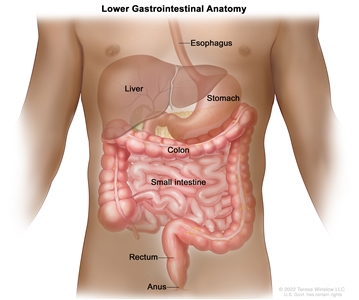
Anatomy of the lower gastrointestinal (digestive) system showing the colon, rectum, and anus. Other organs that make up the digestive system are also shown.
Anal cancer can start in the lining of the anal canal, called the mucosa, or in the perianal skin, the squamous cells outside of the anus that contain hair follicles and sweat glands.
Tumors of the perianal skin that do not involve the anal sphincter are usually treated the same as anal cancers, although local therapy (treatment directed to a limited area of skin) may be used for some.
Most anal cancers are related to human papillomavirus (HPV) infection.
Anal cancer is caused by certain changes to the way anal cells function, especially how they grow and divide into new cells. There are many risk factors for anal cancer, but many do not directly cause cancer. Instead, they increase the chance of DNA damage in cells that may lead to anal cancer. Learn more about how cancer develops at What Is Cancer?
A risk factor is anything that increases the chance of getting a disease. Some risk factors for anal cancer can be changed. However, risk factors also include things people cannot change, like getting older and their health history. Learning about risk factors for anal cancer can help you make changes that might lower your risk of getting it.
Risk factors for anal cancer include:
- being infected with a high-risk human papillomavirus (HPV), especially HPV type 16 or 18. Learn more about HPV and Cancer.
- having a condition or disease that causes a weakened immune system, such as HIV or an organ transplant
- having a personal history of vulvar, vaginal, or cervical cancers
- having many sexual partners
- having receptive anal intercourse (anal sex)
- smoking cigarettes. Learn more about Tobacco (includes help with quitting).
Talk with your doctor if you think you may be at risk.
Signs of anal cancer include bleeding from the anus or rectum or a lump near the anus.
These and other signs and symptoms may be caused by anal cancer or by other conditions. Check with your doctor if you have:
- bleeding from the anus or rectum
- a lump near the anus
- pain or pressure in the area around the anus
- itching or discharge from the anus
- a change in bowel habits
Tests that examine the rectum and anus are used to diagnose anal cancer.
In addition to asking about your personal and family health history and doing a physical exam, your doctor may perform the following tests and procedures:
- Digital rectal examination (DRE) is an exam of the anus and rectum. The doctor or nurse inserts a lubricated, gloved finger into the lower part of the rectum to feel for lumps or anything else that seems unusual.
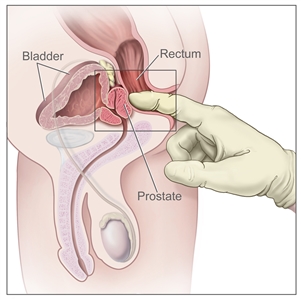
Digital rectal exam (DRE). The doctor inserts a gloved, lubricated finger into the rectum and feels the rectum, anus, and prostate (in males) to check for anything abnormal.
- Anoscopy is an exam of the anus and lower rectum using a short, lighted tube called an anoscope.
- Proctoscopy is a procedure to look inside the rectum and anus to check for abnormal areas, using a proctoscope. A proctoscope is a thin, tube-like instrument with a light and a lens for viewing the inside of the rectum and anus. It may also have a tool to remove tissue samples, which are checked under a microscope for signs of cancer.
- Endo-anal or endorectal ultrasound is a procedure in which an ultrasound transducer (probe) is inserted into the anus or rectum and used to bounce high-energy sound waves (ultrasound) off internal tissues or organs and make echoes. The echoes form a picture of body tissues called a sonogram.
- Biopsy is the removal of cells or tissues so they can be viewed under a microscope by a pathologist to check for signs of cancer. If an abnormal area is seen during the anoscopy, a biopsy may be done at that time.
After anal cancer has been diagnosed, tests are done to find out if cancer cells have spread within the anus or to other parts of the body.
The process used to find out if cancer has spread within the anus or to other parts of the body is called staging. The information gathered from this staging process determines the stage of the disease. It is important to know the stage in order to plan treatment. The following tests may be used in the staging process:
- CT scan (CAT scan) uses a computer linked to an x-ray machine to make a series of detailed pictures of areas inside the body, such as the abdomen, pelvis, or chest. The pictures are taken from different angles and are used to create 3-D views of tissues and organs. A dye may be injected into a vein or swallowed to help the organs or tissues show up more clearly. This procedure is also called computed tomography, computerized tomography, or computerized axial tomography.
- Chest x-ray is a type of radiation that can go through the body and make pictures of the organs and bones inside the chest.
- MRI (magnetic resonance imaging) uses a magnet, radio waves, and a computer to make a series of detailed pictures of areas inside the body. This procedure is also called nuclear magnetic resonance imaging (NMRI).
- PET scan (positron emission tomography scan) uses a small amount of radioactive glucose that is injected into a vein. The PET scanner rotates around the body and makes pictures of where glucose is being used in the body. Cancer cells show up brighter in the picture because they are more active and take up more glucose than normal cells do.
- Pelvic exam is an exam of the vagina, cervix, uterus, fallopian tubes, ovaries, and rectum. A speculum is inserted into the vagina and the doctor or nurse looks at the vagina and cervix for signs of disease. A Pap test of the cervix is usually done. The doctor or nurse also inserts one or two lubricated, gloved fingers of one hand into the vagina and places the other hand over the lower abdomen to feel the size, shape, and position of the uterus and ovaries. The doctor or nurse also inserts a lubricated, gloved finger into the rectum to feel for lumps or abnormal areas.
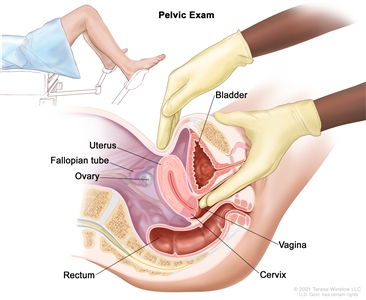
Pelvic exam. A doctor or nurse inserts one or two lubricated, gloved fingers of one hand into the vagina and presses on the lower abdomen with the other hand. This is done to feel the size, shape, and position of the uterus and ovaries. The vagina, cervix, fallopian tubes, and rectum are also checked.
Some people decide to get a second opinion.
You may want to get a second opinion to confirm your anal cancer diagnosis and treatment plan. If you seek a second opinion, you will need to get medical test results and reports from the first doctor to share with the second doctor. The second doctor will review the pathology report, slides, and scans. They may agree with the first doctor, suggest changes or another treatment approach, or provide more information about your cancer.
Learn more about choosing a doctor and getting a second opinion at Finding Cancer Care. You can contact NCI's Cancer Information Service via chat, email, or phone (both in English and Spanish) for help finding a doctor, hospital, or getting a second opinion. For questions you might want to ask at your appointments, visit Questions to Ask Your Doctor About Cancer.
Certain factors affect the prognosis (chance of recovery) and treatment options.
The prognosis depends on:
- the size of the tumor
- whether the cancer has spread to the lymph nodes
The treatment options depend on:
- the stage of the cancer
- where the tumor is in the anus
- whether the person has HIV
- whether cancer remains after initial treatment or has recurred (come back)



